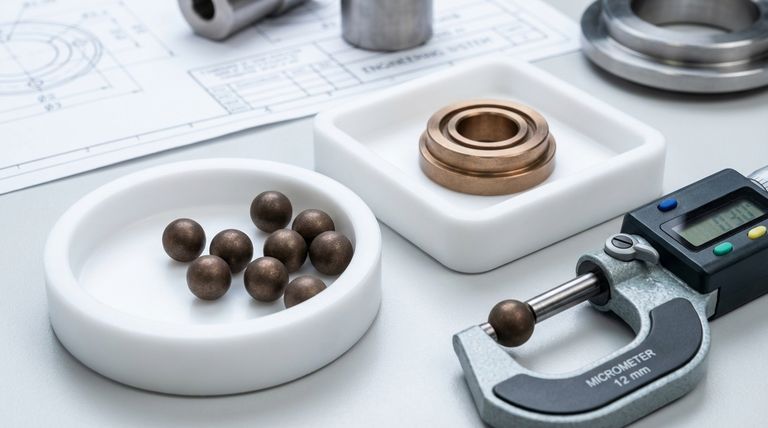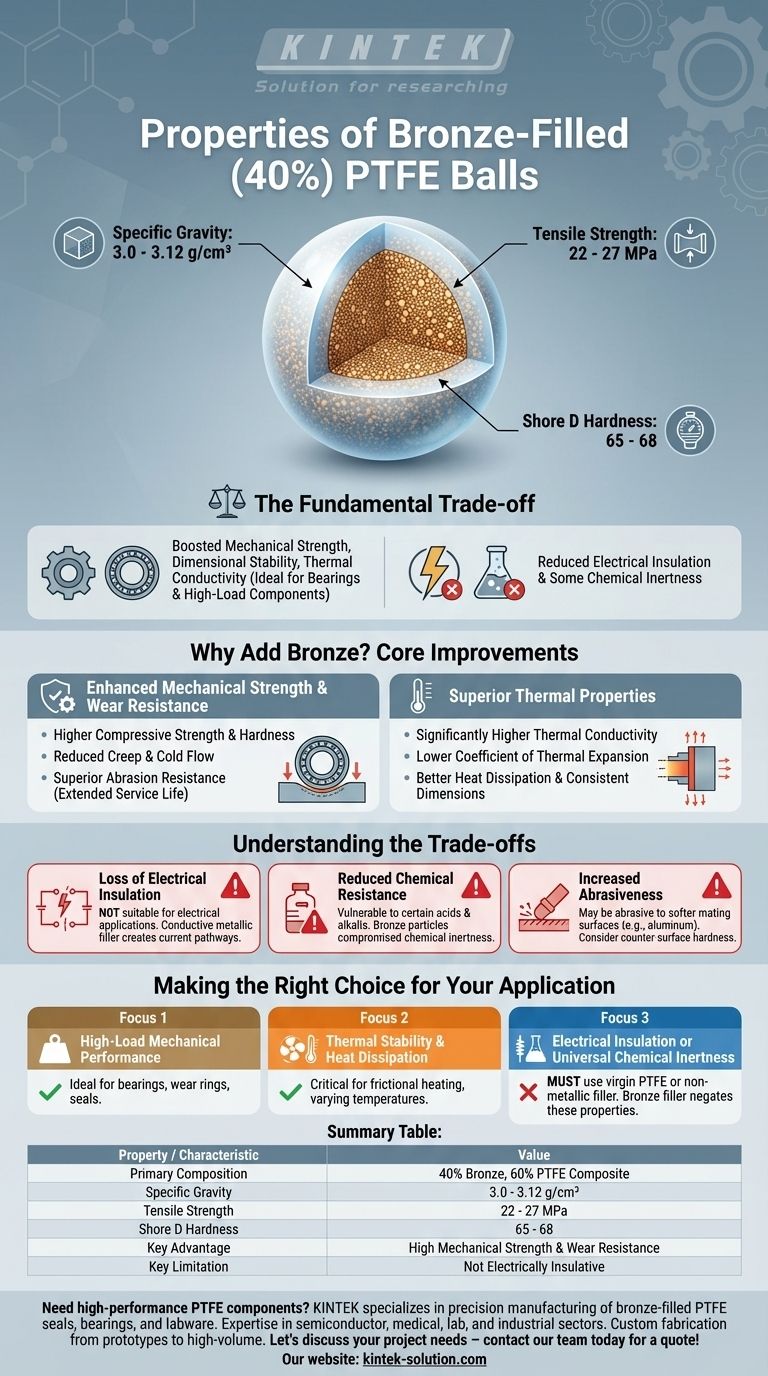At its core, 40% bronze-filled PTFE is a high-performance composite designed for demanding mechanical applications. It possesses a specific gravity of 3.0-3.12 g/cm³, a tensile strength of 22-27 MPa, and a Shore D hardness of 65-68. These properties reflect a material that significantly enhances the strength and wear resistance of standard PTFE.
The fundamental trade-off is clear: adding 40% bronze to PTFE dramatically improves its mechanical strength, dimensional stability, and thermal conductivity, making it ideal for bearings and high-load components. However, this enhancement comes at the cost of PTFE's signature electrical insulation and some of its chemical inertness.

Why Add Bronze to PTFE? The Core Improvements
Adding bronze powder as a filler fundamentally changes the performance characteristics of Polytetrafluoroethylene (PTFE). It transforms the relatively soft polymer into a robust material suited for structural roles.
Enhanced Mechanical Strength and Wear Resistance
The primary benefit of the bronze filler is a massive increase in mechanical integrity. Bronze particles distributed within the PTFE matrix provide a rigid structure that resists deformation.
This results in higher compressive strength and hardness, which drastically reduces material creep and cold flow under sustained load. It also offers superior abrasion resistance, extending the service life of components like bearings and bushings.
Superior Thermal Properties
Bronze is an excellent thermal conductor, while standard PTFE is an insulator. This gives the composite a significantly higher thermal conductivity (compared to virgin PTFE's 0.25 W m⁻¹ K⁻¹), allowing it to dissipate heat from friction more effectively.
Furthermore, the material has a lower coefficient of thermal expansion. This means it maintains its size and shape much better during temperature fluctuations, ensuring consistent clearances and performance in dynamic systems.
Key Physical Characteristics
The most noticeable physical change is the increased density. With a specific gravity of 3.0-3.12 g/cm³, 40% bronze-filled PTFE is considerably heavier than virgin PTFE, which has a density of around 2.2 g/cm³.
Despite the added filler, the composite retains PTFE's characteristically low coefficient of friction, ensuring smooth operation in sliding applications.
Understanding the Trade-offs
No material choice is without compromise. While bronze-filled PTFE is an exceptional engineering material, its advantages in one area create limitations in others.
Loss of Electrical Insulation
Standard PTFE is one of the best electrical insulators known, with a volume resistivity of 10¹⁸-10¹⁹ Ohm-cm. Bronze is a metal and is electrically conductive.
Consequently, bronze-filled PTFE is entirely unsuitable for electrical or electronic applications where insulation is required. The metallic filler creates pathways for current to flow through the material.
Reduced Chemical Resistance
While still highly resistant to many chemicals, the bronze filler compromises the near-universal chemical inertness of virgin PTFE.
The bronze particles can be attacked by certain acids, alkalis, and other corrosive agents that would have no effect on unfilled PTFE. This must be a critical consideration when evaluating the material for use in aggressive chemical environments.
Increased Abrasiveness
The high hardness that provides excellent wear resistance can also be a drawback. Bronze-filled PTFE can be more abrasive to softer mating surfaces, such as aluminum or plastic shafts. The hardness of the counter-surface must be considered in the design.
Making the Right Choice for Your Application
Selecting the correct material requires aligning its properties with the primary demands of your design.
- If your primary focus is high-load mechanical performance: The superior compressive strength, hardness, and creep resistance of 40% bronze-filled PTFE make it the ideal choice for bearings, wear rings, and seals.
- If your primary focus is thermal stability and heat dissipation: The improved thermal conductivity and lower thermal expansion are critical for components that experience frictional heating or operate in varying temperatures.
- If your primary focus is electrical insulation or universal chemical inertness: You must specify virgin (unfilled) PTFE or a non-metallic filled grade, as the bronze filler negates these key properties.
Ultimately, understanding these distinct properties empowers you to select the precise material your application demands.
Summary Table:
| Property | Value / Characteristic |
|---|---|
| Primary Composition | 40% Bronze, 60% PTFE Composite |
| Specific Gravity | 3.0 - 3.12 g/cm³ |
| Tensile Strength | 22 - 27 MPa |
| Shore D Hardness | 65 - 68 |
| Key Advantage | High Mechanical Strength & Wear Resistance |
| Key Limitation | Not Electrically Insulative |
Need high-performance PTFE components for demanding applications?
KINTEK specializes in the precision manufacturing of bronze-filled PTFE components, including seals, bearings, and custom labware. Our expertise ensures you get the superior strength, thermal stability, and wear resistance your application in the semiconductor, medical, laboratory, or industrial sectors requires.
We offer custom fabrication from prototypes to high-volume orders. Let's discuss your project needs – contact our team today for a quote!
Visual Guide

Related Products
- Custom PTFE Parts Manufacturer for Teflon Containers and Components
- Custom PTFE Parts Manufacturer for Teflon Parts and PTFE Tweezers
- Custom PTFE Teflon Balls for Advanced Industrial Applications
- Custom PTFE Bottles for Diverse Industrial Applications
- Custom PTFE Teflon Parts Manufacturer Adjustable Height Flower Basket
People Also Ask
- What is the working temperature range of PTFE? Master Extreme Heat and Cryogenic Applications
- Why is dimensional stability a concern when machining PTFE? Ensure Accurate, Stable PTFE Components
- What are some applications of CNC machined PTFE parts? Critical Components for Medical, Electrical & Food Industries
- What is the temperature range that PTFE can withstand? From -200°C to +260°C for Demanding Applications
- How does PTFE compare to other low-friction plastics like UHMW-PE and Nylon? A Guide to Material Selection



















